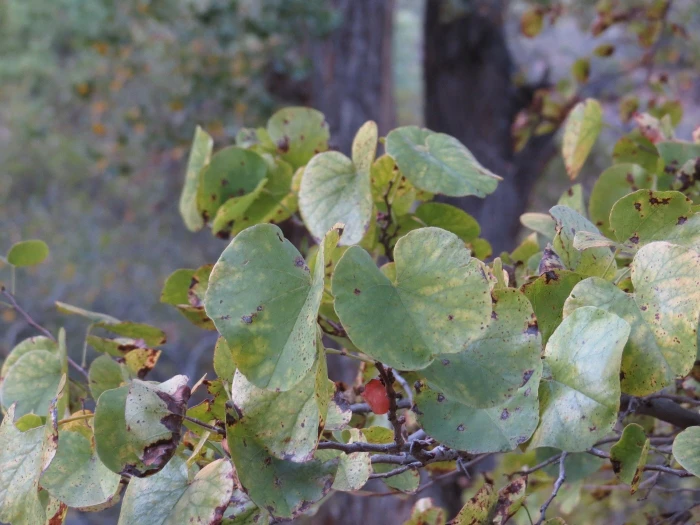California Redbud
(Cercis orbiculata)
California Redbud (Cercis orbiculata)
/
/

Evan M. Raskin
CC BY 4.0
Image By:
Evan M. Raskin
Recorded By:
Copyright:
CC BY 4.0
Copyright Notice:
Photo by: Evan M. Raskin | License Type: CC BY 4.0 | License URL: http://creativecommons.org/licenses/by/4.0/ | Rights Holder: Evan M. Raskin | Publisher: iNaturalist | Date Created: 2016-10-23T07:40:57-07:00 |




Estimated Native Range
Climate Requirements for Deer Park, New York
| This Plant | Your Site | Plant Suitability for Your Location | ||
|---|---|---|---|---|
| • Precipitation | 6" - 36" | 42" | Aquatic | Aquatic |
| • High Temp. | 77°F - 103°F | 82°F | Your summer temperatures are normal for this plant. | Excellent |
| • Low Temp. | 14°F - 39°F | 24°F | Your winter temperatures are normal for this plant | Excellent |
This plant may not grow well at your location - your precipitation is too high.
Summary
Cercis orbiculata, commonly known as California Redbud, is a deciduous shrub or small tree native to chaparral, foothills, and canyons of the southwestern United States, particularly in California and Arizona. It typically grows to a height of up to 15 feet (4.5 meters) and is noted for its rounded, dense canopy. The California Redbud is renowned for its showy, magenta to pink flowers that bloom profusely in early spring before the foliage emerges, creating a striking display against the bare branches. The heart-shaped leaves turn yellow in the fall, adding seasonal interest. Following the flowers, seedpods develop which are also ornamental and persist into winter.
The California Redbud is highly valued for its drought tolerance, making it an excellent choice for water-wise gardens and xeriscaping. It is often used in residential landscapes, native plant gardens, and as a feature plant in public spaces. This species prefers well-drained soils and can thrive in full sun to partial shade. While it is generally low-maintenance, it can be susceptible to fungal diseases if conditions are too moist. It is also important to note that while the California Redbud is adaptable to various soil types, it does not tolerate poorly drained soils well.CC BY-SA 4.0
The California Redbud is highly valued for its drought tolerance, making it an excellent choice for water-wise gardens and xeriscaping. It is often used in residential landscapes, native plant gardens, and as a feature plant in public spaces. This species prefers well-drained soils and can thrive in full sun to partial shade. While it is generally low-maintenance, it can be susceptible to fungal diseases if conditions are too moist. It is also important to note that while the California Redbud is adaptable to various soil types, it does not tolerate poorly drained soils well.CC BY-SA 4.0
Plant Description
- Plant Type: Shrub, Tree
- Height: 15-25 feet
- Width: 15-25 feet
- Growth Rate: Slow, Moderate
- Flower Color: Pink, Purple
- Flowering Season: Spring
- Leaf Retention: Deciduous
Growth Requirements
- Sun: Full Sun
- Water: Low
- Drainage: Medium
Common Uses
Bee Garden, Bird Garden, Butterfly Garden, Drought Tolerant, Hummingbird Garden, Low Maintenance, Showy Flowers
Natural Habitat
Native to chaparral, foothills, and canyons of the southwestern United States
Other Names
Common Names: Western Redbud
Scientific Names: Cercis orbiculata , Cercis canadensis var. orbiculata , Cercis occidentalis var. orbiculata
GBIF Accepted Name: Cercis orbiculata